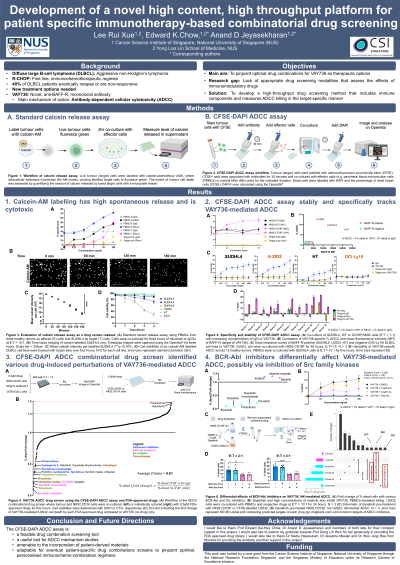Screening Applications & Diagnostics
Poster Session A
(1002-A) Development of a novel high content, high throughput platform for patient specific immunotherapy-based combinatorial drug screening
Tuesday, May 28, 2024
16:30 - 17:15 CEST
Location: Exhibit Hall

- RL
Rui Xue Lee, BSc (Hons)
Graduate Student
National University of Singapore
Singapore, Singapore
Tony B. Poster Author(s)
Abstract: Diffuse large B-cell lymphoma (DLBCL) is an aggressive form of non-Hodgkin’s lymphoma. Patients undergo an immunochemotherapy regimen, R-CHOP, but unfortunately 40% of treated patients relapse, or are non-responsive. There is, therefore, a need for new therapeutic options. Recently, an anti-BAFF-R monoclonal antibody, VAY736, that exerts its anti-tumour effect primarily through antibody-dependent cellular cytotoxicity (ADCC) was identified as a potential therapeutic for DLBCL. With the increasing use of monoclonal antibodies in combination therapies, in-vitro/ex-vivo combinatorial drug screens are necessary to determine the most efficacious antibody-based drug combinations. However, the lack of an immune component in current drug screening precludes the evaluation of immunomodulatory drugs for combinatorial therapy. To address this, using VAY736 as the antibody of interest, we developed a high content, high throughput ADCC assay, where CD16F.NK92 and DLBCL cell lines were used as effector and target cells, respectively. Initial prototypes involved incorporating calcein release chemistry into the assay but due to its cytotoxicity and high spontaneous dye leakage, this fluorometric method proved unsuitable for drug screening. We therefore utilised dead-cell marker and cell tracking dyes to establish a high-throughput, high-content ADCC assay that stably quantified tumour-specific cell death within an NK-DLBCL co-culture. We found that although the level of cell death quantified was not completely dependent on the intrinsic expression of BAFF-R in DLBCL cells, the cell death detected was specific VAY736-mediated ADCC. Furthermore, modifying the assay to include human peripheral blood mononuclear cells (PBMCs) as the effector cells, though exhibiting inter-patient variability across 12 healthy PBMC donors, VAY736-mediated ADCC was determined to be more efficacious than that mediated by rituximab. Finally, through an ADCC combinatorial drug screen applied to DLBCL cells with over 1000 FDA-approved drugs, several drug classes were found to affect the efficacy of VAY736-mediated ADCC, including calcineurin inhibitors and several BCR-Abl inhibitors. Through this, various targetable and potential regulators of VAY736-mediated ADCC were identified, which will guide the development of new drug combinations that enhance the cytotoxicity of VAY736 and other monoclonal antibodies. Overall, this work has demonstrated the feasibility of using the novel ADCC assay as a drug combination screening tool and its amenability to the incorporation of patient-derived materials. Eventually, this novel ADCC assay can be adapted for patient-specific drug combination screens pinpointing optimal, personalised immunochemo-combination regimens.
